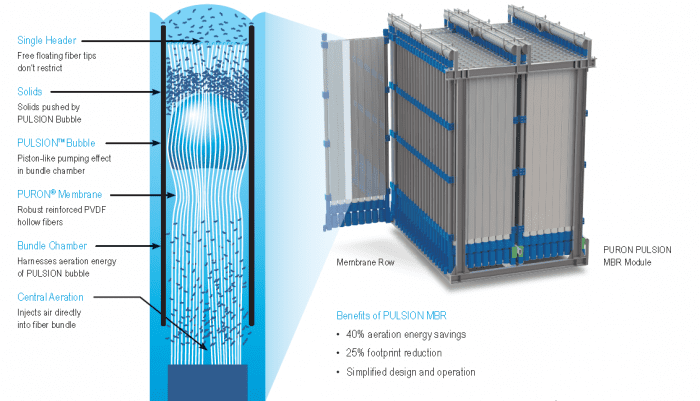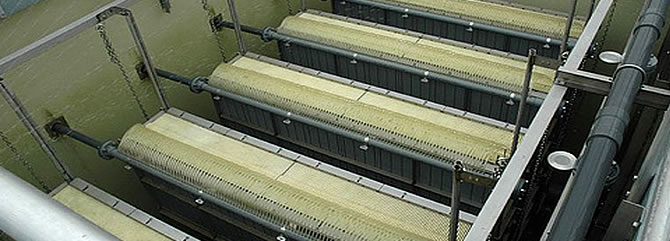Troubleshooting Common Issues with Membrane Bioreactor Systems
Wiki Article
Exactly How Membrane Bioreactors Are Reinventing Water Purification Systems
The introduction of membrane layer bioreactors (MBRs) represents a significant development in the field of water filtration, combining biological therapy processes with sophisticated membrane layer filtering innovations. As worldwide water scarcity increases, the function of MBRs in promoting potable water reuse and lasting water monitoring becomes progressively important.Introduction of Membrane Bioreactors
Membrane bioreactors (MBRs) stand for a considerable improvement in water filtration innovation, as they incorporate biological treatment procedures with membrane purification. This combination boosts the effectiveness of wastewater treatment by using microbes to weaken organic pollutants while concurrently employing semi-permeable membranes to different cured water from suspended solids and pathogens.The MBR system commonly consists of a biological reactor where the microbial population metabolizes impurities, followed by a membrane filtering unit that keeps biomass and allows only tidy water to pass through. This dual functionality causes higher effluent high quality compared to traditional therapy approaches. MBRs can be operated in both batch and constant circulation modes, offering versatility in design and application.
Furthermore, MBRs are identified by their small footprint, making them appropriate for urban setups with room constraints. Membrane Bioreactor. They also allow the recovery of water for reuse, therefore contributing to water sustainability efforts. While MBR technology has obtained appeal in municipal and commercial applications, its operational complexities and energy needs demand mindful factor to consider throughout implementation. On the whole, MBRs go to the leading edge of boosting water therapy performance and high quality, showcasing the possibility for ingenious services in ecological management.
Advantages of MBR Innovation
The combination of biological therapy with membrane layer filtration uses countless advantages for water purification processes. One of the primary advantages of Membrane Bioreactor (MBR) modern technology is its ability to successfully eliminate both not natural and organic pollutants, resulting in top quality effluent. The membrane layers serve as a physical obstacle, protecting against put on hold solids and pathogens from travelling through, which boosts the general security and reliability of cured water.In addition, MBR systems call for a smaller sized footprint contrasted to conventional therapy approaches, enabling for a lot more effective room application. This portable design is particularly helpful in urban settings where land is limited. MBRs likewise show operational adaptability, fitting differing influent high qualities and flow prices without substantial performance degradation.
Additionally, the procedure uses improved nutrient elimination abilities, particularly for nitrogen and phosphorus, which are important for protecting against eutrophication in obtaining waters. The decreased sludge manufacturing related to MBR modern technology also converts to reduce disposal expenses, making it an affordable service in the long run - Membrane Bioreactor. Overall, the advantages of MBR innovation position it as a leading choice for lasting and innovative water filtration systems, dealing with both ecological and financial concerns
Applications in Water Filtration
Applications of Membrane Layer Bioreactor (MBR) technology in water filtration are diverse and impactful, dealing with various treatment needs throughout numerous industries. MBRs effectively combine organic therapy processes with membrane layer filtration, making them excellent for local wastewater treatment, commercial effluent management, and also drinkable water reuse campaigns.In community settings, MBRs are significantly utilized to boost the high quality of dealt with wastewater, allowing for conformity with strict discharge policies and promoting the recycling of water for watering and non-potable usages. Their small layout also makes them ideal for urban environments where area is restricted.
Industrially, MBR modern technology is made use of to deal with procedure water and wastewater, especially in industries such as food and beverage, drugs, and textiles. By successfully eliminating contaminants and suspended solids, MBRs help sectors reduce environmental effects while recovering beneficial sources from wastewater streams.
Additionally, MBRs are obtaining traction in decentralized water therapy applications, where small systems can be deployed in remote locations or creating regions. This versatility enables communities to attain sustainable water administration services, improving access to clean water while minimizing dependence on standard therapy approaches.
Study and Success Stories

In another example, a textile manufacturing center in Bangladesh adopted MBR modern technology to resolve its wastewater challenges. The system lowered chemical oxygen demand (COD) levels from 1,200 mg/L to less than 100 mg/L, hence meeting regulative criteria and significantly minimizing ecological influence.
The College of Cape Town's MBR installation has actually verified effective in dealing with greywater for non-potable reuse on school. This task not just preserves potable water however likewise acts as an educational version for sustainable methods.
Additionally, a fish and browse around here shellfish handling plant in Norway made use of MBR technology to treat effluents containing high degrees of organic matter, attaining over 90% pollutant removal. These case studies underscore MBR innovation's adaptability and its vital function in boosting water top quality throughout diverse applications.
Future of Water Treatment Solutions
As global water deficiency and contamination challenges escalate, ingenious water therapy options are coming to be progressively important to make sure lasting accessibility to clean water. The future of water treatment hinges on the integration of innovative innovations that improve the effectiveness and effectiveness of purification procedures. Membrane why not find out more bioreactors (MBRs) go to the forefront of this development, combining organic therapy with membrane purification to generate premium effluent appropriate for various applications.
Arising trends such as source recuperation from wastewater, including nutrients and energy, will certainly better change treatment facilities into environmentally friendly centers. Developments in nanotechnology and membrane materials assure improved performance and long life of purification systems.

Conclusion
Their function in potable water reuse and sustainable water management highlights their importance in attending to international water shortage obstacles. Proceeded research study and advancement will certainly further enhance the effectiveness and fostering of MBR innovation, making certain a durable future for water therapy services.The emergence of membrane bioreactors (MBRs) stands for a considerable improvement in the field of water purification, merging organic treatment processes with advanced membrane layer filtering modern technologies. As international water deficiency heightens, the role of MBRs in promoting drinkable water reuse and sustainable water management becomes significantly essential. They additionally make it possible for the healing of water for reuse, therefore adding to water sustainability initiatives.As international water shortage and air pollution obstacles escalate, ingenious water therapy Read More Here options are coming to be progressively essential to ensure lasting access to tidy water. Their function in safe and clean water reuse and lasting water administration highlights their relevance in resolving global water scarcity obstacles.
Report this wiki page